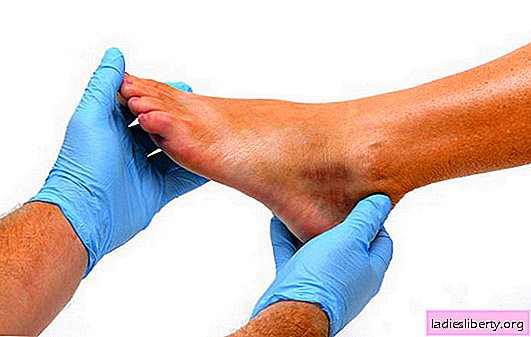
Pain in the little finger is not so common.
Serious diseases of the musculoskeletal system affecting the foot often affect the thumb, but they cannot be ruled out.
Rarely, patients pay attention to pain in the little finger until their intensity becomes high, so most pathologies are diagnosed in the late stages.
It is easier to treat diseases of the musculoskeletal system in the initial stages, the more important it is for patients to carefully listen to their own feelings.
How not to miss terrible diseases and be fully armed?
The little finger on the leg hurts: what are the reasons?
For the most part, the reasons are very "prosaic," but we can talk about serious pathological processes. In the vast majority of cases, the problem lies in violations of the musculoskeletal system of the foot. What problems can be talked about if the little finger on the leg hurts:
• Inflammation of the nail roller due to ingrown nail. This problem often affects the thumb, but due to the anatomical features, it can affect the little fingers. An ingrown nail can provoke an infectious or fungal infection.
• Corn. It is a traumatic keratinization of the skin in places of constant friction or pressure. The little finger is the most frequent localization of corns. An inconveniently worn sock, narrow shoes, all this can cause corns.
• Fungal lesion of the little finger. Fungal lesions are manifested not only by pain, but also by itching, burning inflammation and redness of the skin of the finger. In some cases, deformation of the nail occurs.
Three of these problems make up to 50% (according to medical statistics) of all causes of discomfort in the little fingers of the feet. Other diseases are less common:
• Arthritis. Arthritis is an inflammatory joint disease. It is endogenous: if arthritis is detected, the reasons for this should be sought in the excretory or endocrine systems. In some cases, the source of the disease is an immune reaction, then they talk about rheumatoid arthritis. It proceeds with lethargic symptoms at the initial stage. When the intensity of the symptoms increases, a mature process is discovered during the diagnosis, the treatment of which is much more difficult.
• Arthrosis. Unlike arthritis, osteoarthritis is caused by external circumstances. In the elderly, arthrosis becomes a kind of age norm: the disease is not always aggressive. In young people, a similar pathology is rare. These are mainly young women (due to wearing narrow uncomfortable shoes) and people of both sexes who are engaged in heavy physical labor: athletes, builders, movers, etc.
• Gout. It occurs mainly in men. This is a systemic disease caused by the deposition of urate salts in the articular cavities. The joints of the thumbs mostly suffer, but the little fingers also do not remain outside the pathological process.
• Inflammatory lesions of the anatomical structures of the finger. These are tendonitis (inflammation of the tendons) and bursitis (inflammation of the joint bag). They develop as a result of a prolonged uniform stress of the foot, with a single intense stress also as a result of hypothermia. Pain in inflammatory processes is much more intense, without a clear localization. Unpleasant sensations "spread" all over the foot and intensify when walking.
• Osteomyelitis. Necrotic bone damage. It is rare, but it is extremely difficult: there are symptoms of intoxication of the body, the process is expansive, it rapidly covers not only the bone, but also the surrounding tissues. With a weak immune system, the cause of this dangerous disease can be a banal cut or the presence of a chronic focus of infection in the body (carious cavities, etc.).
• Neuroma. The proliferation of nerve tissue located in the foot. Pain in a neuroma is diffuse, spreading to the entire foot. Favorite places for localization of discomfort are the thumb and little finger. There is no danger to life, however, it is difficult to tolerate.
• Injuries. Obviously, any injury can cause the little finger on the leg to hurt: from a bruise to a fracture.
• Strain. With prolonged uncomfortable position of the foot as a result of wearing poor-quality shoes or improper placement of the foot, deformation of the little finger is possible.
• Problems with the vessels of the lower extremities. Vascular stenosis of the lower extremities leads to a lack of nutrition of the underlying structures, including nerve tissue, which reacts sharply to any changes in blood supply. Atherosclerosis occurs in smokers "with experience", individuals with obesity, in patients with hepatitis, cirrhosis, etc.
• Diabetes. As a result of diabetes, a systemic lesion of the foot structures develops - the so-called. diabetic foot.
The little finger on the leg hurts: diagnosis
According to the symptomatic complex, it is almost impossible to recognize the disease: many manifestations "overlap", others develop in the late stages. Therefore, trying to make a diagnosis yourself is not worth it, it is a futile task and a waste of valuable time. At the first manifestations of discomfort, you must consult a doctor.
The first person to be visited is a community therapist. Instead of a therapist, you can visit a surgeon. These doctors will conduct an initial examination and help develop a further “plan” of action. In the future, a specialized specialist should deal with the diagnosis and treatment:
• Orthopedist - if the source of the problem lies in the pathologies of the musculoskeletal system.
• Traumatologist - when the little finger is injured.
• Rheumatologist - together with an orthopedist helps to cope with the root cause of rheumatoid arthritis.
• Nephrologist - if the reason is the lack of functioning of the excretory system (in particular the kidneys).
• Endocrinologist - for suspected diabetes.
• Phlebologist - specializes in problems with blood vessels.
What studies are used to diagnose the cause of pain in the little finger?
• Oral questioning of the patient. Otherwise referred to as history taking. The doctor asks questions regarding the patient’s condition, his complaints, etc. In this way, the specialist can create an initial picture. The specialist “pushes off” from the information received, as from a springboard in order to take further action. Therefore, the main task of the patient is to tell everything in detail. The more information a doctor receives, the easier and more effective his work will be.
• Inspection. Visual assessment plays almost one of the main roles when it comes to pathologies of the musculoskeletal system. In some cases, it makes it possible already at this stage to suspect a particular disease.
• Functional tests. When the little finger on the leg hurts, a series of tests cannot be dispensed with. These tests are aimed at assessing joint mobility, nerve conduction and sensitivity, the degree of blood supply, etc. They do not cause discomfort, but they are an important source of information. The patient needs to follow the doctor’s commands and talk about his feelings.
• Radiography. Appointed as the first means of assessing the condition of bones and joints. In many cases, an X-ray alone is enough to make a diagnosis.
• Ultrasound of the joints. It is prescribed less often, with suspicions of pathology, such as arthritis, osteoarthritis.
• MRI / CT. May be recommended when all other diagnostic methods have been exhausted. To date, more informative studies of the anatomical structures of the foot have not yet been invented. Tomography in detail displays bones, tendons, soft tissues, joints.
• Puncture of the joint. It plays an important role in the diagnosis of probable osteomyelitis, since it makes it possible in the laboratory to examine the contents of the articular cavity. The causative agent is almost always Staphylococcus aureus.
• Laboratory research. Urinalysis (with gout, the concentration of urates increases), a blood test (shows any inflammation), a biochemical blood test (to detect a high concentration of calcium or urate salts). If you suspect diabetes, a blood sugar test and a glucose tolerance test (called STG or sugar curve) are performed.
It is unlikely that one of the patients can be assigned the entire list of studies. As a rule, the problem is not so deep and lies on the surface, it is important to look carefully.
The little finger on the leg hurts: how and what to treat?
To treat, as well as to examine, is the prerogative of the doctor. You can relieve pain on your own (an analgesic is allowed), get rid of corns (for this you need to steam the legs, but in no case cut the corns, and then exclude the impact on the damaged place) or from the ingrown nail (in the very beginning you just need to cut it off ) Everything else is in the hands of a specialist.
What does modern medicine offer to those with little pink sore feet? For treatment, medications are used, physiotherapy and / or orthopedic treatment is prescribed, in extreme cases, surgery.
Drug treatment is carried out by several groups of drugs:
• Analgesics. For the relief of pain: Analgin, Baralgin, etc.
• Anti-inflammatory drugs. As a rule, non-steroidal, such as Ketorolac, Nise, Ibuprofen, Nurofen. Contribute to the removal of inflammation.
• Steroidal anti-inflammatory.
• Antifungal agents, antibiotics. Appointed in the form of ointments for topical application. With osteomyelitis, the practice of taking antibiotics in the form of tablets or injections.
• Lidocaine, novocaine - for pain blockade.
• Uricosuric drugs - for the treatment of gout.
Orthopedic treatment is prescribed for injuries. Despite the intricate name, the essence is simple: an elastic or plaster bandage is applied to immobilize the little finger. Physiotherapy is practiced both as a therapeutic method, and during the rehabilitation period after an injury. Specific procedures are prescribed by a physiotherapist.
Surgery can not be dispensed with if the joint is destroyed (in this case, prosthetics are performed) or a severe injury was received. Far-reaching osteomyelitis involves the amputation of the little finger and surrounding tissues, if they were affected.
Pain in the little finger rarely talks about serious diseases, but you can not ignore them. It is never impossible to know in advance what kind of problem it is. It makes more sense to appear to a specialist, excessive vigilance is normal practice.











